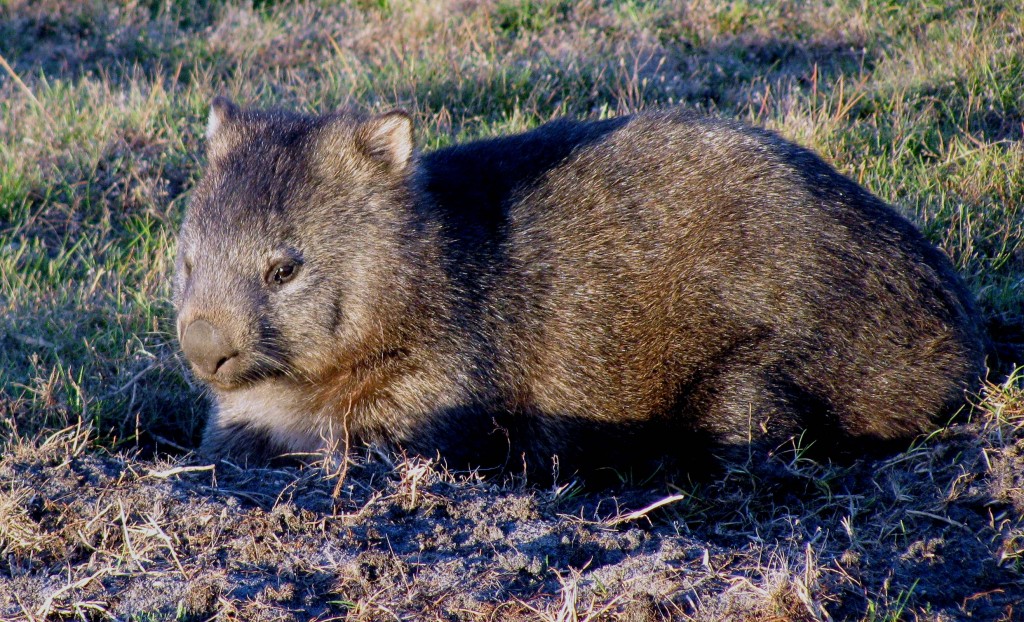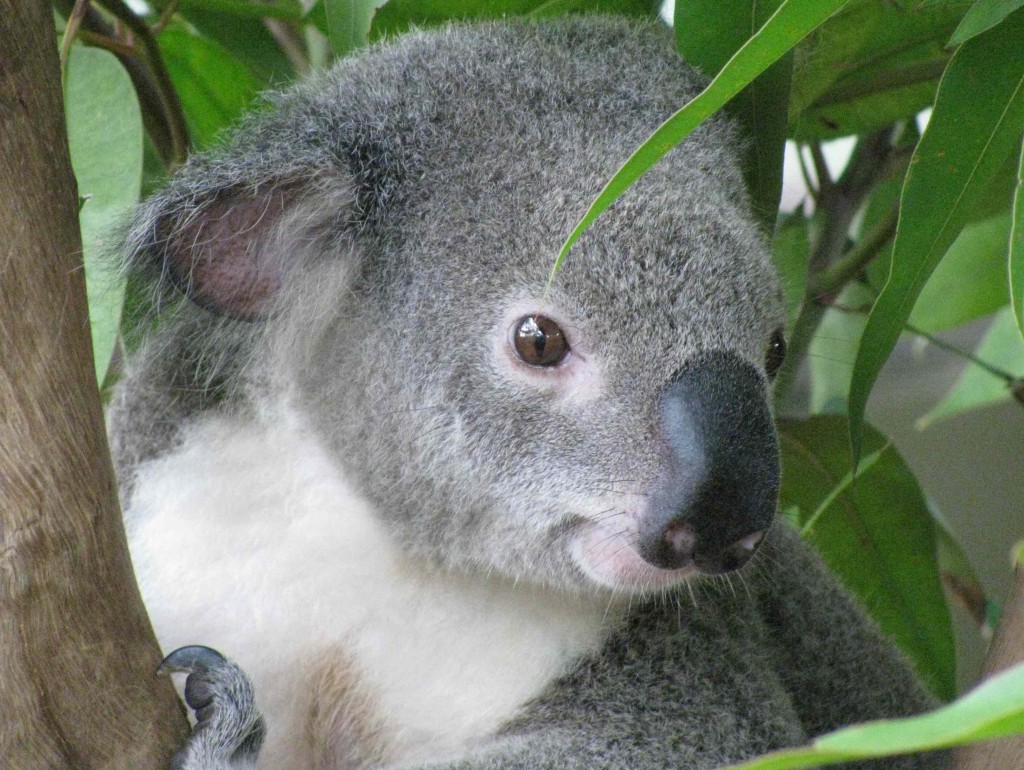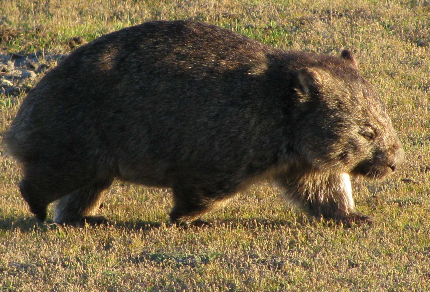
Common Wombat on Dried Plant ‘Nest’ (© Vilis Nams)
While Townsville stewed in morning showers and downpours, I continued catching up blog posts from our Victoria/Tasmania trip and investigated wombats. Last evening, I signed out two wombat-related prizes from the Aitkenvale library. The first is a field guide to Australian mammal scats and tracks, within which I read that wombats often deposits their cube-shaped feces in prominent places1 (hence the wombat turds on the corners of boardwalks or on rocks beside trails in Tassie). The second is James Woodford’s The Secret Life of Wombats,2 which – with Vilis and I having seen common wombats up so close we could hear the sound of their teeth ripping off blades of grass – I knew I simply had to read. As you can tell, Narawntapu National Park and its chunky marsupial denizens made a big impression on me.
From The Mammals of Australia, a weighty tome edited by Ronald Strahan, I learned that the scientific name of the common wombat is Vombatus ursinus, which recognizes the Aboriginal origin of the marsupial’s name, as well as the wombat’s superficial similarities to a bear.3 The concise, dry text also informed me that common wombats are about a metre long, weigh on average 26 kilograms (although very heavy individuals have weighed up to 39 kilograms), and have a large, naked nose, thick, coarse fur, and small, rounded ears.4 They can be found within patches of forest, open woodland, heath, and scrubland in Tasmania and in a strip along the southeast coast of mainland Australia.5 They are herbivores and ardent burrowers with a liking for their own company.3

Koala
All three of Australia’s wombat species (the others being the northern and southern hairy-nosed wombats) are related to koalas,6 a similarity both Vilis and I noted while observing the common wombats in Narawntapu National Park. This relationship is particularly striking in the common wombat, with its large, bare nose. The connection is visible in the wombat’s body shape and movements, too. Both of the hairy-nosed varieties of wombats have much more restricted distributions than the common wombat, with the southern hairy-nosed wombat occurring in pockets of arid grassland in southern South Australia and extreme southeastern Western Australia7, and the northern hairy-nosed wombat found only within 300 acres in Epping Forest National Park in Queensland.8
From Barbara Triggs’ Tracks, Scats and Other Traces: A Field Guide to Australian Mammals, I learned that wombats leave pigeon-toed footprints that look a little like the footprint of a young, barefoot child, but with claw marks often showing,9 and that fresh wombat scats smell like wombats – a mix of strong peaty and sweet essences.10 Photographs showed a warren of burrows of the southern hairy-nosed wombat, with trails leading to and between burrow entrances, like curved cul-de-sacs leading to residences in a fairytale hamlet.11 Another photo illustrated a rubbing post, and another, scratchings beside a pile of dung.12 In Narawntapu, Vilis and I spotted common wombat scat scattered all over the grazing plain, as well as burrows either in the open grassland or under the shelter of a patch of shrubs, and nests of dried fern and grass ‘straw.’
The Secret Life of Wombats, written by James Woodford, took me on a sweeping journey through the palaeontology and biology of wombats, as well as offering glimpses into the lives of a surprising collection of wombat scientists and protectors. From his book, I learned that Europeans first encountered wombats in 1797, when the Sydney Cove became shipwrecked near an island off the coast of present-day Tasmania.13 The island was – fortunately for the crew – heavily populated with strange, chunky, plant-eating mammals that were easily clubbed to death and proved good eating for the stranded sailors, who named the island Preservation Island.13 I also learned that wombats are considered the most intelligent of all marsupials,14 that southern hairy-nosed wombats are extremely efficient consumers of little water,15 and that the northern hairy-nosed wombat is likely the most endangered species of large mammal in the world.16
And then there were the people. Peter Nicholson, as a 15-year-old at the wilderness school at Timbertop in Victoria, fell in love with wombats and explored their burrows, documenting the wombats homes and habits so thoroughly that his science report on his findings, written 50 years ago when he was a schoolboy, is still quoted by wombat scientists today.17 Gaylene and Rob Parker of New South Wales raised over 200 orphaned wombats and returned them to the wild.18 Rob Wells, the world’s top southern hairy-nosed wombat expert, spent four hours stuck in a pitch-black wombat burrow until rescued by a farmer on whose land he was working.19 They, and Woodford, were captivated by wombats, as were Vilis and I at Narawntapu . However, this sentiment is by no means shared by all. Wombats are regarded as troublesome pests by many farmers, who don’t appreciate their burrowing prowess.20
After supper, Vilis and I watched another Australian movie written and directed by Rolf de Heer, this film called The Tracker (for Ten Canoes see http://maginams.ca//2010/02/03/ ). Commissioned by the Adelaide Festival of Arts 2002 and Special Broadcasting Service Independent, the movie is set in 1922 and chronicles the revealing journey of four men in pursuit of a black fugitive – one, a fanatically racist police officer, one a greenhorn officer with a sense of justice, one a reluctant assistant who doesn’t interfere, and one an Aboriginal tracker from a faraway homeland whose job it is to lead the white men to the fugitive.
David Gulpilil, who narrated Ten Canoes and played the role of King George, Nullah’s magic-man grandfather in Australia, offers a riveting performance as the tracker, who throughout the movie regains his sense of self in the face of the senior officer’s blatant, deadly hatred for blacks and willingness to kill his own men to achieve his goals. Filmed in the Arkaroola Wilderness Sanctuary in South Australia – a landscape of bleak, serrated ridges, rock, spinifex, stunted scrub, and more rock – the film is an homage to this country’s most arid state, as well as a hard look at the cultural collision between Europeans and Aboriginals in the early 20th century. When it ended, Vilis and I just sat for a while, then nodded to each other, having caught a glimpse of the heartbeat of this country with its chest wide open.
References:
1. Barbara Triggs. Tracks, Scats and Other Traces: A Field Guide to Australian Mammals. 1996. Oxford University Press, Melbourne. pp. 164-165.
2. James Woodford. The Secret Life of Wombats. 2001. Text Publishing, Melbourne. 226 p.
3. J.C. McIlroy. Common Wombat. p. 204 In: Ronald Strahan, editor. The Mammals of Australia. 1995. Reed New Holland, Sydney; 4. Ibid, p. 205; 5. Ibid, pp. 204-205.
6. Ronald Strahan. Suborder Vombatiformes. p. 194 In: Ronald Strahan, editor. The Mammals of Australia. 1995. Reed New Holland, Sydney.
7. R.T. Wells. Southern Hairy-nosed Wombat. p. 202 In: Ronald Strahan, editor. The Mammals of Australia. 1995. Reed New Holland, Sydney.
8. C.N. Johnson and G. Gordon. Northern Hairy-nosed Wombat. p. 200 In: Ronald Strahan, editor. The Mammals of Australia. 1995. Reed New Holland, Sydney.
9. Triggs, pp. 44-45; 10. Ibid, p. 165; 11. Ibid, p. 214; 12. Ibid, p. 215.
13. Woodford, pp. 39; 14. Ibid, p. 11; 15. Ibid, p. 12; 16. Ibid, p.10; 17. Ibid, Chapter 1, Wombat Boy, pp., 1-35; 18. Ibid, pp. 112, 126; 19. Ibid, pp. 174-179; 20. Ibid, pp. 187-189.
21. About Australia. South Australia Facts. ©1997-2010. Accessed 12-Jul-2010. http://www.about-australia.com/facts/south-australia/


